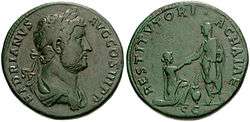Roman provincial currency
| Numismatics |
|---|
.png) |
| Currency |
| Circulating currencies |
|
| Local currencies |
| Fictional currencies |
| History |
| Historical currencies |
| Byzantine |
| Medieval currencies |
| Production |
| Exonumia |
| Notaphily |
| Scripophily |
|
Roman provincial currency was coinage minted within the Roman Empire by local civic rather than imperial authorities. These coins were often continuations of the original currencies that existed prior to the arrival of the Romans.
When a new region was assimilated into Roman civilization, the continuance of pre-existing local currencies was often allowed as a matter of expediency. Also, new colonies were frequently given authority to mint bronze coins. These provincial currencies were mostly used by the local inhabitants only for local trade – as their intrinsic values were usually much lower than Roman imperial coinage.
Characteristics
|
Provincial coins were issued in silver, billon and bronze denominations, though never gold. The majority were bronze. Silver and billon coins were more common in the Eastern regions of the Empire, particularly Alexandria. In general, the issuance of silver coinage was controlled by Rome. That gave the imperial government a measure of control and influence throughout the empire. Some coins that circulated in the eastern parts of the empire may have been minted at the mint of Rome.
Issuance
There were over 600 provincial mints during the Imperial Era.[1] The mints were located throughout the Empire, with a particular concentration in the Eastern portions of the Empire.
Major provincial cities such as Corinth or Antioch possessed their own minting capabilities. Some mints issued only for their cities (Viminacium) while others issued coins for entire province (e.g. Moesia). There are several cities known by their coins, as there is no historical mention of them.
Gallery
-

Drachma of Alexandria. Obverse: Bust of Alexander Severus, 222-235 AD. Reverse: Bust of Asclepius.
See also
References
- ↑ David R. Sear,Greek Imperial Coins,Seaby 1982,2001
External links
- Roman Provincial Coins
- Coins on Wildwinds.com
- Coins with similar Designs
- Roman Egypt coins
- Area of issues


